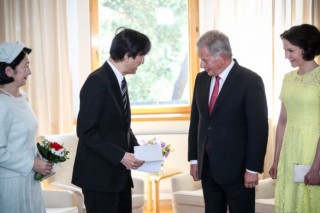Loading
Search
▼ Royal Visit Burnishes Finland’s Business And Culture Profile In Japan
- Category:Other
Crown Prince Akishino and Princess Kiko are touring Helsinki, Espoo and Turku as part of their visit.
The visit of Japan’s Crown Prince and Princess to Finland officially marks 100 years of diplomatic relations between the two countries, but it also raises the Nordic nation’s profile as a partner for Japanese companies and as a gateway to European markets.
Crown Prince Akishino only took over the role in May this year, when his older brother succeeded their father as Emperor of Japan, and this marks Akishino’s first overseas trip since then.
During his four-day visit Akishino and his wife Crown Princess Kiko – hosted by President Niinistö and First Lady Jenni Haukio – are visiting Helsinki, Espoo and Turku, “exploring Finnish culture, landmarks, nature and healthcare” according to the President’s office.
The visit of Japan’s Crown Prince and Princess to Finland officially marks 100 years of diplomatic relations between the two countries, but it also raises the Nordic nation’s profile as a partner for Japanese companies and as a gateway to European markets.
Crown Prince Akishino only took over the role in May this year, when his older brother succeeded their father as Emperor of Japan, and this marks Akishino’s first overseas trip since then.
During his four-day visit Akishino and his wife Crown Princess Kiko – hosted by President Niinistö and First Lady Jenni Haukio – are visiting Helsinki, Espoo and Turku, “exploring Finnish culture, landmarks, nature and healthcare” according to the President’s office.
Finland’s profile in Japan
Whether it’s the enduring appeal of Moomins or bright Marimekko fabrics, Finnish design and culture enjoys robust popularity in Japan these days.
Earlier this year Moominvalley Theme Park opened outside Tokyo, part of the Metsä Village development which immerses visitors in Nordic lifestyle and culture with design shops and food outlets, a forest and small lake.
It’s a slice of Finland close to one of the world’s biggest metropolises.
In April hundreds of pieces of art from the Moomin Museum in Tampere were unveiled in Tokyo, another part of the centenary celebrations of diplomatic relations.
Even small Finnish businesses like Mercedes Chocolaterie from Åland have found themselves in demand with Japanese shoppers who seek high quality imported goods with an appealing design asthetic.
The small-batch chocolates with flavours like sea buckthorn have been popular at high-end department stores for the last few years, especially in the month leading up to Valentine’s Day. The company’s website, in Swedish English and Japanese, is a sign of how important the Asian market can be.

Changing balance of trade
After Japan dominated trade relations for decades, the balance of trade between the two countries these days is firmly in Finland’s favour.
Since 2011 Finland has had a growing trade surplus with Japan, and in 2018 it reached almost €723 million.
Going in the other direction from Japan to Finland, the growth in trade has been more modest, up just over 5% in 2018.
But the figures don’t tell the whole story.
“Due to international business, trade statistics only partly reveal the actual business of companies. Today, most of the Japanese cars, electronics and machinery which makes up most of Japan’s export to Finland are produced close to the markets, in Finland’s case in Europe” explains Antti Kunnas, Executive Director of the Finnish Chamber of Commerce in Japan.
The same applies the other way too. Exports like wood, paper and telecoms equipment sold by Finnish companies to Japan could be produced in third countries. The actual volume of trade is certainly higher than the official figures.
Which Finnish products are lucrative in Japan?
Traditional wood and manufactured goods are the most popular Finnish items in Japan, accounting for 25% of export sales. Combined with paper and paperboard the two sectors form just over a third of all Finnish exports.
Exports of metals have also been on the rise in recent years – particularly Finnish cobalt which can be used in batteries for mobile devices, or in rechargeable batteries for electric vehicles.
“The rise in trade for the past two years has been quite positive but there is still more room for growth” Antti Kunnas tells News Now Finland.
“Looking at the business environment in Japan, it can be said that you are sitting on a gold mine as there is a tremendous amount of unused opportunities for foreign companies” he adds.
Easier market entry for Finnish companies
A landmark EU-Japan trade agreement signed earlier this year opens up the possibilities for increased business between the Asian nation and the 28-country block of the European Union.
The agreement cuts down on red tape, reduces export and investment-related costs, and slashes tariffs on more than 90% of Japan’s imports from the EU making it more cost effective for Finnish companies to place their products on Japanese supermarket shelves.
After Japan dominated trade relations for decades, the balance of trade between the two countries these days is firmly in Finland’s favour.
Since 2011 Finland has had a growing trade surplus with Japan, and in 2018 it reached almost €723 million.
Going in the other direction from Japan to Finland, the growth in trade has been more modest, up just over 5% in 2018.
But the figures don’t tell the whole story.
“Due to international business, trade statistics only partly reveal the actual business of companies. Today, most of the Japanese cars, electronics and machinery which makes up most of Japan’s export to Finland are produced close to the markets, in Finland’s case in Europe” explains Antti Kunnas, Executive Director of the Finnish Chamber of Commerce in Japan.
The same applies the other way too. Exports like wood, paper and telecoms equipment sold by Finnish companies to Japan could be produced in third countries. The actual volume of trade is certainly higher than the official figures.
Which Finnish products are lucrative in Japan?
Traditional wood and manufactured goods are the most popular Finnish items in Japan, accounting for 25% of export sales. Combined with paper and paperboard the two sectors form just over a third of all Finnish exports.
Exports of metals have also been on the rise in recent years – particularly Finnish cobalt which can be used in batteries for mobile devices, or in rechargeable batteries for electric vehicles.
“The rise in trade for the past two years has been quite positive but there is still more room for growth” Antti Kunnas tells News Now Finland.
“Looking at the business environment in Japan, it can be said that you are sitting on a gold mine as there is a tremendous amount of unused opportunities for foreign companies” he adds.
Easier market entry for Finnish companies
A landmark EU-Japan trade agreement signed earlier this year opens up the possibilities for increased business between the Asian nation and the 28-country block of the European Union.
The agreement cuts down on red tape, reduces export and investment-related costs, and slashes tariffs on more than 90% of Japan’s imports from the EU making it more cost effective for Finnish companies to place their products on Japanese supermarket shelves.

The amount of rules and regulations involves in entering the Japanese market – as well as the language – had been a barrier to business until now.
“Finland as a country, and through that also Finnish companies, have an extremely positive image in Japan and with the removal of tariffs through [the EU-Japan trade agreement] growth chances for Finnish companies have never been better” says Kunnas.
“Finland as a country, and through that also Finnish companies, have an extremely positive image in Japan and with the removal of tariffs through [the EU-Japan trade agreement] growth chances for Finnish companies have never been better” says Kunnas.
- July 4, 2019
- Comment (0)
- Trackback(0)



